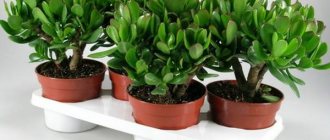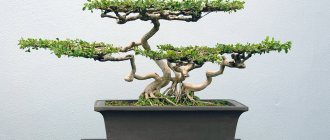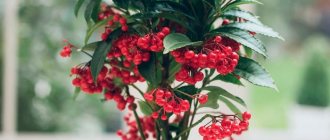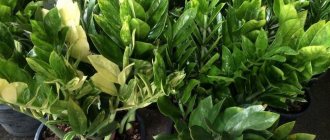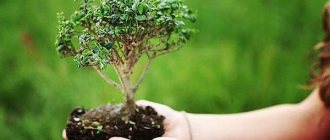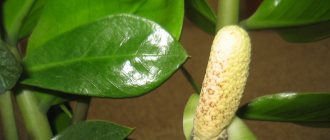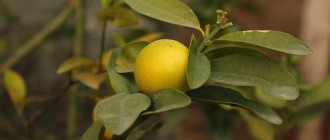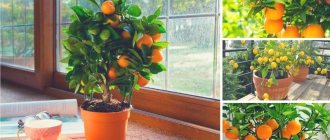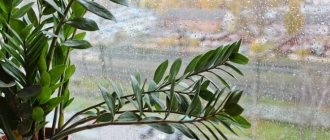Albizia is a genus of the Mimosa subfamily, uniting several species of tropical deciduous shrubs and small trees. The plants are native to several regions, including the Hindustan Peninsula, Iran, Turkey, Thailand, southern China, Japan, and Azerbaijan. Thanks to its ornamental greenery and flowers, albizia is widespread as a greenhouse and home crop in areas with temperate climates.. In areas with mild winters it is grown in open ground.
Albizia - silk acacia
Albizia attracts attention with its bright flowers, reminiscent of exotic acacia flowers. In our gardens we grow Albizia Lankaran , which is sometimes called silk acacia. Those who have ever vacationed in Crimea have probably seen an elegant shrub on the Black Sea coast, which locals call coastal “mimosa.”
Park albizia with a dense umbrella crown is popular in all tropical and subtropical countries. It is very similar to a real acacia: the same double-pinnate leaves and fluffy flowers, in which very long stamens stand out. In our climate, these beautiful deciduous plants prefer to be kept in tubs. In the south of the republic, one of the umbrella acacias - Albizia Lankaran - is widely grown in open ground. It can be distinguished from the Caucasian acacia (silver “mimosa”) only by its flowers, since it has the same finely dissected feathery leaves. And only when the adult plant puts on its soft pink outfit, and in the summer, and not at the end of winter, like the “mimosa”, the mistake becomes obvious: we have albizia.
Indeed, albizia flowers have very long staminate filaments, which, depending on the variety, can be white, pink or red, which makes them highly decorative.
Albizia Lankaran is a large deciduous tree 10-12 meters high. It has a spreading umbrella-shaped crown, like some types of tropical acacias. Albizia leaves are lacy, dissected into many small lobes. According to some scientists, the birthplace of this plant is Lankaran (a city in Azerbaijan).
Lenkoran shrub is a plant of a dry, warm climate, but even in the coldest winters for our conditions, the albizia is not damaged. Apparently this is due to climate change. The only thing that has remained unchanged is that Albizia is light-loving and cannot grow in the shade of other trees.
Albizia begins to leaf out late, at the end of May, when almost all the trees have already blossomed. Albizia blooms profusely and for a long time - from mid-June until September-October, depending on the weather. In autumn, it retains its leaves for a very long time (sometimes until the end of November), which few trees in our climate are capable of. Albizia remain green until the last moment, and can only be destroyed by sudden frosts.
Albizia propagates by seeds, cuttings, and root shoots. But albizia seeds require “hot” stratification. To do this, the seeds are soaked for 5-6 hours in hot water (+60 C), after which they are sown. You can also use the usual “cold” stratification, which the seeds undergo in winter right in the ground. When sowing in autumn, seed germination in spring is about 80%, and single seeds can sprout within a year. In the first year, Albizia seedlings grow slowly and by autumn they rarely reach a height of 20 cm. You should not feed them at this time: you can burn the roots of young plants. In addition, with an excess of nitrogen fertilizers, the growing season of plants is delayed, and the wood of seedlings may not ripen well by winter. Then, during severe frosts, the plants can suffer greatly. You can start feeding albizia seedlings from the second year of life, gradually increasing the dosage.
Vegetative propagation of albizia is used more often. Some trees produce root shoots that can be separated and transplanted when the plants are dormant. Yes, and Lenkoran acacia is cut satisfactorily: you can use both lignified and green cuttings.
Lignified cuttings are cut from the previous year's annual growths. Cuttings with 2-3 buds are taken from the middle of the shoot, treated with root formation stimulants and planted in a permanent place in loose, fertile soil. After 3-4 months, rooting usually occurs by 70-80%.
Many acacias are grown as ornamental trees. Albizia is perfect for creating spectacular hedges, undergrowth and alleys. Sometimes used as a tapeworm. The main economic purpose is landscaping, securing slopes, and constructing windbreaks.
Albesia tree photo
In the Other Arts section, to the question: Tropical albesia tree, from which figurines are made in Indonesia - where does it grow, type, color of wood? asked by the author Irina Kuzmina the best answer is Exotic souvenirs and interior items from the islands of Bali, Java, Kalimantan, Timor, Lombok (Indonesia) Sculpture made from tropical wood is a type of fine art, the works of which have a volumetric-spatial form, surface treatment and details complement the expressiveness plastic solution of the sculptural image. Soft tree species (albesia and mahogany) are used to make sculptures. These rocks are easy to cut and expressively tolerate the plasticity of products. Giraffes (sculptures and figurines made of tropical wood)Figures of these graceful animals are made of natural wood (albesia), individually painted or decorated (batik, shell), and coated with a special protective varnish. Handcrafted, they demonstrate craftsmanship and are an excellent gift that symbolizes insight and foresight. Birds (sculptures and figurines made from tropical wood) Represent success, glory and prosperity, inspiring take-off in life. Winged creatures with powerful energy that help them rise above the most unfortunate circumstances of life. The islands of the Indonesian archipelago abound with many tropical birds (herons, flamingos, various parrots). These and other birds are very popular among wood sculpture carvers. Flamingos - birds of dawn - are unusual, remarkably beautiful. Unnaturally bright plumage, unusual body shape, exquisite plastic movements. The heron is a symbol of the reproduction of life, as well as longevity. Seeing her is a good sign. Bird figurines made of natural wood are individually painted and protected with a special varnish applied over the paint. Elephant (sculptures and figurines made of tropical wood) The elephant is a leisurely, majestic animal that personifies wisdom, strength and power. An elephant figurine brings stability and peace, prosperity, happiness and longevity to the home. Elephant figurines made by hand from natural wood. Fish (sculptures and figurines made of tropical wood) Fish is a symbol of silence and philosophy, the possession of knowledge and wisdom. Fish figurines made of natural wood, made by hand using various decors. Figures and sculptures of coral fish are especially popular; the riot of colors is conveyed by original and delicate carvings or skillful painting with natural paints. Cat (sculptures and figurines made of tropical wood) The cat is independent, unusually graceful and elegant, a symbol of royalty, femininity and longevity. Also, a cat is a symbol of home comfort and a warm, calm atmosphere in the house. Cat figurines are a great gift that brings incomparable spiritual comfort, because it is not for nothing that a cat is believed to heal the soul and body. Camel (sculptures and figurines made of tropical wood) Camel is a symbol of strength and endurance , the ability to take on the burden of worries and carry them alone through difficulties, easily overcoming adversity and hardship. A symbol of individual leadership both in work and in life. Masks (made of tropical wood) Some Balinese theatrical performances require masks of comic and tragic characters. In Indonesia, masks are widely used in various rituals to achieve the favor of ancestors or a good harvest, to get rid of dangers and diseases. Now Indonesian craftsmen offer for sale simply beautiful craft masks, trying to maintain historical accuracy in them, not carrying an esoteric load, which look great in any interior.
An ordinary miracle
Maria Yurasova, AiF. At the dacha”: Grigory Aleksandrovich, do you have any examples of successful cultivation of trees and shrubs that were previously considered unstable in central Russia?
– Personally, I don’t have many “crazy” examples of my own. I am a cautious person, I try not to take risks. In my work, I always rely on information that I was able to obtain in advance, and I approach the matter with a certain hope of success. But in my department there are employees who have a completely different approach - adventurous. And I welcome it, because thanks to this they are doing a lot of interesting things. For example, we have swamp cypress growing here. He is over 10 years old and has already grown 7 meters. It definitely shouldn't have survived here since the tree is native to Florida. But nevertheless it grows! There are several Lawson Cypress trees that tend to die in our climate. They suffered for a long time, but still survived, survived the extreme winter of 2006, and I hope that they will continue to live. This is real luck. Another “crazy thing” is Paulownia pubescent - a native of the subtropics of China. It lives, grows and simply shocks everyone with its huge leaves and incredible annual growth. And of course, our magnolias. Some of them are already regularly flowering and bearing fruit.
– What is the main reason that such plants, which are exotic for us, have been growing and blooming for many years now - the correct agricultural technology or, after all, the special microclimate of Moscow University?
– Both matters. But agricultural technology, of course, comes first. And not just its observance, but a person’s approach to the plant. Kind attitude, caring. Thanks to this, not only correct agricultural technology is born, but also a certain information exchange takes place between man and plant, in which I firmly believe. Without any mysticism and obscurantism. The plant, figuratively speaking, simply begins to “understand” what they want from it. Although the microclimate, of course, is also important.
– To what extent does the country of origin – say, Poland, Germany or Russia – influence the stability of a seedling of a heat-loving plant in our climate? Or are the natural conditions in which a particular species exists more important?
– Of course, the fate of a plant is influenced to a greater extent by its genes: where it was formed, in what conditions, how its genetic program works. For example, Norway maple: bring it from any country and there will be no problems with it.
As for more heat-loving plants, for them the area of origin, of course, matters. If they are grown here, with us, then it will be more reliable planting material than obtained somewhere near Poznan.
Types and varieties
The Robinia genus consists of twenty species of trees and bushes. All of them are bred for decorative purposes. Robinia can be propagated by seeds that have been subjected to preliminary stratification.
Young bushes are sensitive to low temperatures. Over time, resistance to the winter season increases. But if there is no snow, then the bush should be protected from frost. Growth is rapid, especially in the first ten years. The tree tolerates pruning and replanting well, does not make any special claims to the soil composition, and prefers dry areas.
White acacia blooms every year after the bulk of the trees and shrubs have faded. The decorative qualities of the plant make it possible to use it for landscaping parks, gardens, and streets. It looks great in group plantings and alone.
1. Robinia adhesive grows up to eleven meters in height, has a wide and rounded crown and smooth bark. Robinia owes its name to the sticky hairs covering the inflorescences, shoots and petioles of foliage. There are no thorns or they are small. The foliage reaches twenty centimeters in length and stays on the branches for a long time even in the autumn season. The flowers are large in shape, colored in pinkish-violet tones, do not emit a scent, form straight clusters that abundantly cover the tree during the flowering period.
2. Another variety is Robinia New Mexican. This is not a very large tree or shrub, growing up to twelve meters in height. The shoots are covered with numerous thorns, the foliage is large, gray-green, and has hairy petioles. The flowers are pink-violet, without fragrance. Flowering lasts from the beginning of the summer season until September, with short breaks. This species grows the fastest and tolerates frosty winters best. It thrives in urban conditions and does not require fertile soil areas. New Mexican beauty looks great when in bloom. Growing is not a complicated process. The main conditions are plenty of sunlight and the absence of groundwater near the surface.
3. Robinia false locust is a deciduous tree that has a variety of decorative forms. It looks like a pyramid or has an umbrella-type crown. The foliage is single-leaved or dissected. Inflorescences are white or pinkish.
4. Bristle-haired Robinia looks like a bush, not exceeding three meters in height. It is covered with reddish bristles, the flowers are colored pink.
Robinia planting rules
Robinia varieties are planted in the spring, before buds form. Fall planting is not recommended as cool soil will damage the roots, causing them to rot. Planting should not be done too deep to avoid damping off. A soil composition of sand and compost, to which you can add dolomite, ash and crushed limestone.
An unpretentious plant will help decorate any area, filling it with colorful blooms.
Knowledge is power
– Sometimes some amateur enthusiasts manage to “tame” certain species or varieties of plants, the possibility of cultivating which we previously questioned. After this, they often launch an entire advertising campaign, declaring them absolutely sustainable, for example, in the Moscow region or throughout central Russia. To what extent, from your point of view, is such a position justified?
– It is completely unfounded. I also know such examples. Usually these people sell their own planting material. The goal of such advertising is to sell as much as possible. I have already said that I am a conservative and adhere to a different approach, which I have developed over many years of work. When collecting information about any plant, one must focus on existing botanical collections. In Moscow alone, for example, there are several botanical gardens. There are arboretums in the country. There are nurseries that also conduct their observations. This is an extremely important point. There are observations, which means people can be trusted. And the longer they last, the more reliable the information. After all, the very concept of a botanical garden is formulated as a documented collection of plants. Records are kept: where the plant came from, when it was planted, and what happened to it over the years. With special attention to extreme seasons. I consider the observation threshold to be 15–20 years, because during this time, as a rule, all natural disasters that can happen occur: severe drought, extremely cold winters, extremely long frosty periods, and the like. After this, you can already draw conclusions. Any person who wants to find out whether a plant of interest will survive in a given geographical location should turn to the nearest documented collection. There are people working there who, in fact, devote their lives to this. They will immediately tell whether a given plant has a chance or not. And those who are primarily trying to sell have no time for observation.
When and how does it bloom
The variety of inflorescence shapes, their colors and the arrangement of foliage has divided albizia into several types.
This is about:
- silk (Lenkoran, or Iranian) variety (Albizia julibrissin), which is characterized by fern-like leaf blades consisting of asymmetrical crescent-shaped lobes, and dense capitate or spicate flower racemes, in which the corollas and many long stamens are almost invisible;
bunch-flowered (Albizia lophantha), the peculiarity of which is the yellow cylindrical flower spikes, the length of which often reaches 5 cm.
Did you know? Since ancient times, any variety of acacia has been considered a symbol of stability and renewal. This is evidenced by references to the plant in documents found by historians. And on ancient Egyptian artifacts, archaeologists still find images of sarcophagi with acacia sprouts growing from them. These pictures eloquently indicate that life comes only after death.
Both types of silk tree have a long flowering period. In the first option, this period begins in the last ten days of May and, under favorable climatic conditions, can last until October. During the warm autumn season in Crimea, cases were recorded when the tree delighted passers-by with fragrant flowers until the frost itself. The second variety is distinguished by earlier blooming of buds. The plant enters this phase from March to June.
Silk and tufted acacias have very fragrant and honey-bearing flowers. Moreover, the pleasant smell with pronounced notes of raspberries and violets persists throughout the entire flowering period.
Real result
– Some gardeners, growing trees and shrubs with a compact root system on a plot, practice digging them up in the fall and placing them in the basement or other suitable place for the winter, and returning them to the ground in the spring. Is it worth adopting such experience if possible? What is better to use: good shelter in the open air or such movement?
– Of course, it’s best to try to keep the plant in one place, because any transplant is incredibly stressful for it. Some species can actually be grown this way, for example dahlias. But woody plants are a completely different matter. They do not have the same resting mechanism as tuberous plants: for them, using such techniques is torture. Plus, you get a completely different result. After all, the real goal is to introduce the plant into cultivation in open ground. A person who has achieved this can safely turn up his nose and even brag. Carrying plants through frost-free basements can, in principle, preserve anything, but this is not acclimatization. In this regard, I have a very good example - yew berry. Before the Great Patriotic War, botanists claimed that it would not grow here. But it worked! In our garden it produces seeds, and every year we find several dozen self-seeding plants. When self-seeding occurs, this means that the plant begins to reproduce naturally, and this is the highest degree of adaptation of the plant to the climate. Here it is - the result of acclimatization! This is not my merit - my predecessors. But now we already have plants of our own reproduction, and we can be proud of this.
Maybe someone will disagree with us and say: “What difference does it make?” But if a person has acclimatized the plant, this is the result for everyone. If he runs to the basement and shakes over his copy, then no one else needs it except him.
General information
Albizia owes its name to the botanist Filippo del Albizzi. He was the first to bring this plant to Europe.
Albizia julibrissin belongs to the legume family (Fabaceae). It has other names: Lankaran acacia, silk albizia, Crimean mimosa, julibrissin albizia. This tree reaches a height of just over 10 meters. The roots are located at the surface of the soil. The smooth gray bark becomes cracked with age. Delicate white flowers have a large number of long pink stamens. The silk tree bears fruit in pods up to 20 cm long, which contain seeds - beans. The leaves are openwork, light green, reminiscent of mimosa foliage. This is a deciduous plant.
It grows wild in the tropical climates of Australia, South Africa, and South America. It is cultivated in subtropical regions.
Varieties of albizia
Acacia Lankaran is widely known in Crimea . The dense spreading crowns of this plant are used not only for decorative purposes, but also to create shady alleys. It should be taken into account that Lankaran acacia has low frost resistance, so for the winter its young shoots are covered with spruce branches or a special covering material. This plant tolerates frosts down to -15°C. At home, a common variety is called Albizia Pompadour.
The genus Albizzia is also known for the sickle-shaped albizzia (Albizzia falcata). This fast-growing tree is grown commercially in Indonesia for its pulp.
Planting Robinia
The choice of location for planting a robinia seedling is determined by the plants’ need for light. Natural protection from the north wind is also desirable for pink robins.
All robins should be planted in the spring, before buds open. The fact is that during autumn planting, the soil is too cold for the growth of the roots of these heat-loving plants and too wet, which is why the roots damaged during digging immediately begin to rot. In no case should you plant robins too deep - all because of the same danger of damping off. The ideal soil quality is a combination of sand and compost with the obligatory addition of some alkaline substance - ash, dolomite flour, old slaked lime, crushed limestone.
In general, these plants thrive much better on poor but loose soils than on rich and clayey soils. When planting on a clay area, you can try, as when growing stone fruit crops, planting on a mound, when the surface of the tree trunk circle, after settling, is above the soil level.
Features of Robinia
- Life form - Tree.
- Size - Height 20-25 m, width 12-20 m, trunk diameter up to 1.2 m.
- Crown - Openwork rounded.
- Leaves - Unpaired, 20-30 cm long, light green, poisonous.
- Flowering - In May-June, the flowers are white, fragrant, collected in racemes 10-25 cm long.
- Fruits - Beans up to 12 cm.
- Growth characteristics - Annual growth from 20 cm to 1 m at a young age.
- Durability - Up to 100 years.
Attitude:
- to the light - photophilous;
- to the soil - not demanding, but prefers light soils, tolerates salinity;
- for moisture - moderate watering;
- to the wind - not wind resistant;
- to temperature - frost-resistant.
Urban conditions - Smoke and gas resistant.
Decorative - Decorative during flowering.
Application - As a single tree, group plantings and alleys, it can strengthen soil on slopes.
Robinia pseudoacacia
Sowing seeds indoors
In open ground, Lankaran acacia is propagated by cuttings. Another way to propagate albizia is by growing it from seeds at home. First you need to prepare the containers and soil for planting. Tools and pots are disinfected with potassium permanganate, and the soil is warmed up. Expanded clay or river pebbles are poured onto the bottom of the container.
Growing pelargonium at home and caring for it
Composition of the soil mixture:
- 3 parts of turf land;
- 2 parts peat;
- 1 part sand.
Sowing is carried out in late February and until mid-July at room temperature +25°C. Before planting, the grains are soaked in warm water for 2-3 days. To make the sprouts hatch faster, the beans are carefully sawed, breaking their hard shell. Next, the seeds are planted to a depth of 4 mm and watered with a growth stimulator.
When seedlings of Albizia Lankaran, when grown from seeds, have true leaves, they are planted in containers with a diameter of about 8 cm. After the last frost, the seedlings are transferred to open ground, leaving gaps of about 2 m between plants. The place should be well lit, but at noon slightly shaded from the sun. A slightly acidic, light and nutritious substrate is desirable.
Brief description of silk tree
The tree, which emerged from the subtropics of Southeast Asia, attracts the attention of gardeners with its exotic flower structure and non-standard flowering period. Abundant flowering continues from July to August
Often each flower lives for one or two days. The inflorescence of silk action is a spherical bunch of thin stamens. Some species form clusters of inflorescences collected in spikelets. From a distance they resemble fluffy cylinders.
Experienced gardeners use this species for growing bonsai. The subtropical plant reaches one and a half meters in height when grown indoors and up to ten meters in open ground. The double pinnate leaves grow up to 20 centimeters in length. The branches form an umbrella-shaped crown, which is characteristic of Australian and African flora. Flowering ends with the formation of beans with seeds.
The subtropical plant successfully grows in warm climates close to subtropical: on the Crimean Peninsula, Moldova, southern Ukraine, Georgia, etc.
Growing albizia at home
Currently, the cultivation of silk tree as an indoor crop is not yet as widespread as an outdoor one. Although this is a tropical plant, it is not picky about its conditions. And if you know the peculiarities of growing Lenkoran acacia , planting and care, then it will reward you with its original flowering.
- Albizia grows well in bright light. The eastern and western sides are suitable for it; on a southern window in summer it is better to shade it a little from direct sunlight. In the summer, you can take the plant outside, initially covering it from the scorching sun.
- The optimal temperature for growing Lankaran acacia is +20…+25°C. During the rest period, maintain a regime of about +10°C. It should be taken into account that the silk tree is a deciduous plant, and do not worry about shedding leaves at this time.
- During growth, albizia should be well watered, but without stagnation of water in the soil. Since the root system is superficial, the top of the soil should also be constantly moist. During the dormant period, it is necessary to water the soil weekly. It is better to use settled water at room temperature.
- Acacia is fed from March to August, during the period of intensive growth. Fertilizers for decorative deciduous plants are applied every 15-20 days. During budding and at the beginning of flowering, you can use fertilizer with a high content of phosphorus and potassium.
Crimean mimosa does not require high humidity. The air of an ordinary apartment suits her quite well.
Possible difficulties during cultivation
Albizia are capricious and sensitive to changes in usual conditions. Excessive air dryness and insufficient moisture levels lead to paleness, early wilting of leaves and falling flowers. The reason may be excessive water hardness or the presence of lime salts in it.
Waterlogging of roots during watering causes them to rot . The development of rot is promoted by insufficiently loose heavy soil and lack of drainage. In such a situation, it is difficult to save a dying plant. You can try to restore it by rooting the remaining healthy shoots.
The appearance of dark spots on the leaves indicates an incorrect temperature regime: keeping the plant in a draft or in a cold room.
Symptoms of improper care
Sometimes the plant does not bloom and looks unhealthy. There are several main signs of poor health in silk albizia:
- Dropping unopened flowers. The reason is underwatering the plant. It is necessary to water more often, not allowing the top layer of soil to dry out.
- Fading, blanching of vegetative parts. The reason is a lack of nutrients, improper watering, and lack of lighting. Replant in new soil with good aeration, constantly moisten the soil without stagnating water. Move the flower to a more illuminated place.
- Drying of leaves along the edges and at the tips. The reason is too dry air, possibly from heating devices. The plant should be sprayed and moved away from the battery.
- Dark spots on leaves. The reason is incorrect air temperature, drafts. It should be removed away from the windows, not placed next to the door.
Caring for calathea at home: planting and methods of propagation
The lacy foliage of Albizia and the spicy aroma of its inflorescences will create a unique atmosphere in your home. Not even the most experienced gardener can cope with this unpretentious plant; the main thing is to ensure proper watering and a sufficient amount of light.
Diseases and pests
When planted in suitable soil and following all the rules of care, albizia practically does not get sick. Garden specimens are extremely rarely damaged by parasites. Houseplants can become victims of scale insects and spider mites. The risk of pest attack increases if there are succulents in the same room as the albizia. You can get rid of scale insects by wiping the branches and leaf blades with a swab soaked in insecticide. Brown plaques must be removed manually .
The whitish coating and thin cobwebs entangling the leaves are washed off with infusions of garlic, tobacco dust or onion peels. It is necessary to spray the greens daily until the signs of parasites disappear.
Lankaran acacia
Albizia julibrissin, synonym Lenkoran acacia, silk acacia or silk tree. Albizia Lankaran belongs to the legume family (Fabaceae), a low ornamental tree that looks spectacular during mass flowering.
The tree forms a wide umbrella crown. The annual rings have a dark greenish coating of bark. The bark of lignified branches is gray, sometimes vertical light spots are visible. Many shoots have a zigzag shape.
The leaves are openwork, bipinnate, grow up to 45x25 cm. Because of the leaves that close at night and during rain, it is known in the world as the “ Persian mimosa ” or “ Sleeping tree ”.
A double complex inflorescence appears at the top of the shoots. A single flower is collected in a capitate inflorescence, the inflorescences are collected in loose panicles. The flowers have no petals; instead of petals, there are long threads of stamens growing from a greenish bowl. The flowers are honey-bearing and fragrant, especially at night. In nature, flowers are pollinated by moths and hummingbirds.
The fruit is a long (10-20 cm) pod containing several large seeds.
There are two botanical varieties:
- Albizia julibrissin var. julibrissin
- Albizia julibrissin var. Mollis. Differs from the described species in dense hairs on the shoots.
There is also a form of Albizia julibrissin F. Rosea - a smaller tree with pink flowers. Since it is found in the northernmost regions of North Korea and China, it tolerates much lower winter temperatures than species.
There are selective varieties. Popular ones are:
- 'Chocolate Summer' has dark carmine brown leaves and pale pink flowers.
- "Ishii Weeping" (or 'Pendula') - characterized by the drooping shape of the shoots.
Natural habitats are South and East Asia, from Iran to Korea, China to Japan, Crimea. Height in nature up to 12 meters. Lankaran acacia, planted in open ground, rarely reaches 4 meters, at home - 2-2.5 meters. Flowering , in the warmest part of summer, when the temperature difference between day and night is not too high. The color of the flowers, the stamens, are white right on the cup, gradually turning into pink.
When growing in open ground, two conditions must be met. Plant in a sunny, sheltered place . When grown in a container outdoors, place it under the midday sun (after hardening), when grown at home, provide the most illuminated place, with sunlight only in the morning. The southern sun behind the glass will burn the leaves. Later, Lankaran acacia will shed damaged leaves.
When growing outdoors, you don't have to worry about the soil. On one condition. The soil must be permeable. The secret to surviving albitia in the ground is planting it after 3 years of growing in a container. We are talking about a partially or completely woody plant that will survive the winter. Zone 7a and 7b. There may be a risk of outdoor cultivation in the western part of zone 6b. The top priority is a well-protected location.
Keeping the soil slightly moist for quite a long time after planting will help the plant take root well. A good root system increases the chances of winter survival. For safety, you can dig around the acacia no lower than 30 cm. The base of the embankment should be wide. It is assumed that the most important are the roots located on the circumference of the shadow that the crown of the tree casts in the southern hours. If a cold winter destroys the shoots above the embankment, the frozen parts of the acacia are removed in the spring, and new shoots with a high growth rate (up to 1 meter per year) will grow from the dormant buds under the embankment. The tree will become a bush. A shrub is easier to protect for the winter than a small tree.
When grown in containers, the basis is a permeable substrate. The cheapest leavening agent used is aquarium gravel. The smallest grain is purchased and mixed in half with the soil. Since even large pots are light, several large stones are placed on the bottom - previously well washed, there will be a drainage layer and a stability stabilizer. After transplantation, the substrate in the pot is kept in a state of light moisture during the growing of the acacia. If the substrate has poor permeability, be careful with watering. It is not good to dry out the soil; it is even worse to over-moisten it. Lankaran acacia is susceptible to diseases caused by waterlogging, a practically incurable disease called fusarium . Preparing the right substrate should not be underestimated. Since acacia grows quite quickly after 6-8 weeks, fertilizing is done. Use a universal fertilizer for potted plants. If Albizia starts to set buds, switch to fertilizers for flowering plants. In mid-September, the application of fertilizers is limited. Firstly, half the dose is applied; from mid-October, the plant is fertilized with half the dose, every month.
When growing Lankaran acacia outside, bring it into the room the night before the first frost. Indoors, Albizia is installed in the brightest place without direct sunlight during the daytime. Morning or afternoon sun will not harm the plant.
Albizia: planting and care in open ground
When growing and cultivating albizia in open ground, it is necessary to take into account when and where it is best to plant it. This plant is planted in early spring or autumn. For planting, it is advisable to select sandy areas with sufficient moisture content.
In the warm southern climate, the question of how to grow this plant in open ground is not difficult. The main thing is to apply fertilizers containing phosphorus on time and carry out formative pruning of the crown in the spring.
Thanks to its ornamental greenery and flowers, albizia is widely distributed as a greenhouse and home crop in areas with temperate climates. In areas with mild winters it is grown in open ground.
In the Moscow region, albizia can be planted in open ground only a few years after planting in room or greenhouse conditions, so that the tree can acclimatize. In the middle zone there is shorter daylight hours and therefore it is important to organize additional lighting. If the plant feels a lack of light, the leaves will begin to turn yellow and fall off.
After leaf fall, Albizia goes into hibernation. In the middle zone and more northern regions of Russia, when preparing for wintering, it is best to trim the shoots. It is also advisable to hill up the root collar and cover the plant with non-woven material in several layers. The height of the snow cover above the plant is also important. But even if these recommendations are followed, the tender southern albizia may not survive the winter.
If Albizia begins to fold its leaves, a white coating appears on them, or the leaves fly off, it is quite possible that the plant is affected by a pest. Most often spider mites and scale insects. In this case, it is necessary to treat the plant with an insecticide or use traditional methods, such as spraying with tobacco infusion or onion peel.
Albizia is a beautifully flowering, honey-bearing tree that can become one of the best decorations and add exoticism to both the garden plot and the home interior. And with the right approach, observing the peculiarities of caring for the southern beauty, it can be grown in open ground conditions and in the middle climatic zone.
Reproduction
Propagated by sowing seeds. Seeds remain viable for a long time. The main condition is a suitable substrate for sowing. The substrate cannot be rich in fertilizers; the plant must create a reliable root system with appropriate efforts. The soil for flowers is full of pathogens, often the seeds germinate well, and 10 cm seedlings begin to fall - fusarium or blackleg. For sowing, a specially prepared substrate is used. In the spring, it is not difficult to buy a substrate called “ sowing soil ”.
Due to their hard shell, the seeds need to be prepared. Sometimes it is enough to put the seeds in warm water and put them on the radiator for a day. Some seeds will need a second day. You can help by using sandpaper. Seeds are sown one at a time in small pots. The seedlings cannot tolerate transplantation because of their long roots and can be broken; it is better to sow one at a time.
It is better not to sow for the winter. Seedlings require good lighting.
Albizia - silk bush
Albizia Lankaran (lat. Albizia julibrissin) is a species of trees of the genus Albizia of the Legume family.
The following Russian names for the plant are found: Lankaran acacia, silk acacia, silk bush.
Albizia julibrissin. © Butko
The first part of the scientific name - Albizia - comes from the name of the Florentine Filippo del Albizzi (Italian: Albizzi), who introduced this plant to Europe in the 18th century. The specific epithet - julibrissin - is a corruption of gul-i abrisham (Persian: گل ابریشم), which in Farsi means “silk flower” (from gul گل - “flower”, abrisham ابریشم - “silk”).
Two varieties are described:
- Albizia julibrissin Durazz. var. julibrissin
- Albizia julibrissin Durazz. var. mollis (Wall.) Benth.
Albizia julibrissin. © Mark McLeod
Morphology
It has a spreading, umbrella-shaped crown. The height of the tree is 6 - 9 meters. The width of the tree is 6 - 7 meters.
The leaves are doubly pinnate and lacy. The color of the leaves is light green. The leaf length reaches 20 centimeters. Albizia sheds its leaves in winter.
Blooms in July-August. The flowers are collected in corymbose panicles. The flowers are yellowish-white. The stamens are long and pink.
The fruits of Albizia are beans. The length of the fruit reaches 20 centimeters.
The tree grows for 50-100 years.
Albizia julibrissin. © szakszonlaszlo
Albizia julibrissin. © szakszonlaszlo
Spreading
Albizia is quite widespread in urban areas of central and northern Argentina and, from a decorative point of view, is a tree of open spaces - streets, squares and parks. As a rule, you will not see Albizia in enclosed patios or front gardens. This umbrella acacia is especially decorative during the flowering period from mid-summer to autumn, when its lush crown, formed by large double-pinnate mimosa leaves, is covered with thousands of whitish-pink fluffy inflorescences.
As an ornamental plant, Albizia has conquered the whole world, lying not only in the subtropical and tropical regions, but also in areas with a temperate warm climate in Europe, the Mediterranean, Crimea and the Black Sea coast of the Caucasus. In the southern regions of Ukraine, Albizia is essentially the most beautiful tree that blooms profusely for several months (July-October). It is cultivated a lot in Crimean cities. Albizia is especially numerous in Kerch, where alleys and many parks of the city are decorated with it.
Albizia julibrissin. © szakszonlaszlo
Care
Albizia prefers sunny places and neutral sandy (one-third of the volume) soils. It is moisture-loving, but adult plants are quite resistant to drought and can also withstand short-term frosts of up to 10-15 degrees. Tolerates pruning well.
Reproduction by flattened spindle-shaped brown seeds (up to 10 mm in length), ripening up to 10-14 pieces. in hanging flat beans. Before sowing, the seeds should be poured with hot water and kept in water for 1-2 days until completely swollen. The seeding rate is 1.5-2 g per 1 linear meter. Late sowing - at the end of April - beginning of May in warm soil. Easily propagated by self-sowing. In the southern regions of Russia and Ukraine, such annual plants reach 20-30 cm in height by September (data for Kerch, Crimea, 2004). Tolerates transplantation well up to 6-8 years. Thanks to the large number of nodules (nitrogen-fixing bacteria) on the roots, it enriches the soil with nitrogen.
In indoor culture, due to late flowering in adulthood and the presence of other beautifully flowering and similar decorative species, it is usually not accepted.
Albizia julibrissin. © Mugzemet
0
Back
How to plant a lawn: instructions for a beginner
MORE
Application
Due to its decorative qualities and exotic appearance, albizia is used in landscape design. In regions with a subtropical climate, its varieties gradually adapt to unusual winter temperatures: trees are planted in gardens and on the streets. In harsher climates it is a houseplant.
Albizia Lankaran is used in folk medicine . The bark and flowers contain a number of pharmacologically active substances:
- triterpenoids;
- glycosides;
- saponins;
- lignans;
- tannins.
Water infusions and decoctions of albizia have anti-inflammatory, antimicrobial, and sedative effects. They are useful for nervous disorders, insomnia, headaches, tachycardia, gastrointestinal diseases, helminthiases, and genitourinary infections.
During the flowering period, the silk tree is a good honey plant . The bark, due to its pigment content, is used as a raw material for the production of natural dye.
